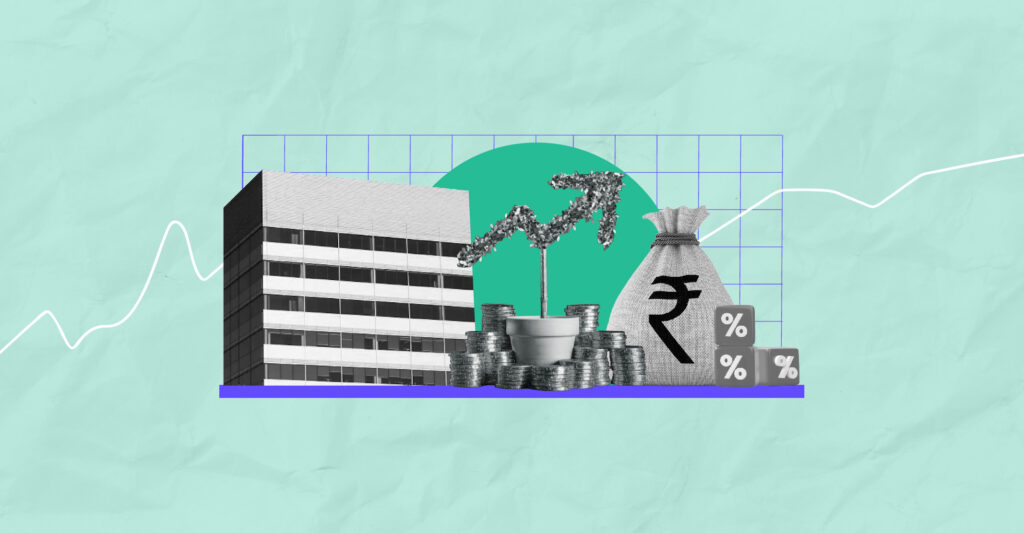Last Updated on Jul 30, 2024 by Anjali Chourasiya
The Indian stock market categorises listed companies based on their market capitalisation, which refers to the total worth of a company. There are three categorisations of market cap – large cap, mid cap, and small cap. Also known as blue chip stocks, large cap stocks are shares issued by a company with over Rs 20,000 cr. Mutual funds primarily investing in such stocks are called large cap funds or blue chip mutual funds. In this blog, we have encapsulated the list of the top 10 large cap mutual funds based on their 5-yr CAGR. But before we delve deeper, let’s understand the terms that we will frequently be mentioning in this blog –
Table of Contents
What is a large cap stock?
Large cap stocks belong to NIFTY 100. It boasts of companies that are leaders in their sectors and are perceived to be less risky. Moreover, large cap stocks are touted to be the most stable stocks as they are of established and reputed companies. Therefore, investors who want to approach a less risky route to wealth creation invest in large cap stocks as they are known for their stability in the market.
What are large cap mutual funds?
Simply put, large cap mutual funds are equity funds that invest in the top 100 stocks of India based on their market capitalization. These stocks are primarily leaders across market sectors. Also known as blue chip mutual funds, they are less risky than mid and small cap funds as market movements do not heavily impact them. These are stable and generate consistent returns compared to mid and small cap funds.
Top 10 large cap mutual funds in India
| Large-cap Mutual Fund Name | AUM (Rs. in cr.) | CAGR 3Y (%) | CAGR 5Y (%) | NAV | Volatility (%) |
| Canara Rob Bluechip Equity Fund | 10,089.74 | 21.79 | 16.10 | 52.50 | 9.46 |
| Baroda BNP Paribas Large Cap Fund | 1,517.48 | 22.40 | 15.74 | 182.35 | 9.45 |
| Nippon India Large Cap Fund | 15,583.03 | 31.71 | 15.58 | 71.99 | 10.03 |
| Kotak Bluechip Fund | 6,369.87 | 22.98 | 15.05 | 479.14 | 9.39 |
| SBI BlueChip Fund | 38,881.48 | 24.68 | 14.70 | 78.17 | 9.01 |
| Edelweiss Large Cap Fund | 530.97 | 23.41 | 14.70 | 71.16 | 9.77 |
| ICICI Pru Bluechip Fund | 40,078.90 | 25.93 | 14.55 | 85.80 | 9.25 |
| Invesco India Largecap Fund | 797.13 | 22.02 | 14.25 | 58.14 | 9.86 |
| Tata Large Cap Fund | 1,613.33 | 24.58 | 14.05 | 427.10 | 9.72 |
| HDFC Top 100 Fund | 25,775.56 | 28.19 | 13.89 | 923.93 | 9.80 |
Note: The data is as of 27th September 2023, and the parameters used to filter the large-cap mutual funds are:
- AUM (Assets Under Management)
- 3-yr CAGR
- 5-yr CAGR – set from high to low
- NAV (Net Asset Value)
- Volatility
About best large-cap mutual funds in India
Canara Rob Bluechip Equity Fund
Sitting on an AUM of Rs. 10,089.74 cr., this large cap fund has an expense ratio of 0.45%. The fund has grown at a 3-yr CAGR of 21.17%, which showcases its stability to generate consistent returns in the long-term. The fund is managed by Shridatta Bhandwaldar and Vishal Mishra, having an experience of 10 yrs each.
- Minimum lumpsum amount – Rs. 5,000
- Sector Distribution – Private Banks, IT Services & Consulting, Oil & Gas – Refining & Marketing, Construction & Engineering, Specialized Finance, among 27 other sectors.
Baroda BNP Paribas Large Cap Fund
Sitting on an AUM of Rs. 1,517.48 cr., this blue-chip fund has an expense ratio of 0.95%. Talking about the mutual fund returns, the 3-yr and 5-yr CAGRs are 22.40% and 15.74%, respectively.
- Minimum lumpsum amount – Rs. 5,000
- Sector Distribution – Private Banks, IT Services & Consulting, Oil & Gas – Refining & Marketing, Construction & Engineering, among 29 other sectors.
Nippon India Large Cap Fund
This large cap fund has an AUM of Rs. 15,583.03 cr. and an expense ratio of 0.90%. The 3-yr and 5-yr CAGRs of the fund are 31.71% and 15.58%.
- Minimum lumpsum amount – Rs. 100
- Sector Distribution – Private Banks, Oil & Gas – Refining & Marketing, IT Services & Consulting, Hotels, Resorts & Cruise Lines, Public Banks, among 28 other sectors.
Kotak Bluechip Fund
This fund by Kotak Mutual Fund has an AUM of Rs. 6,369.87 cr. and an expense ratio of 0.59%.
- Minimum lumpsum amount – Rs. 100
- Sector Distribution – Private Banks, IT Services & Consulting, Oil & Gas – Refining & Marketing, Construction & Engineering, Four Wheelers, among 24 other sectors.
SBI BlueChip Fund
This large-cap mutual fund has an AUM of Rs. 38,881.48 cr. and an expense ratio of 0.88%.
- Minimum lumpsum amount – Rs. 5,000
- Sector Distribution – Private Banks, Construction & Engineering, Specialized Finance, Pharmaceuticals, FMCG – Tobacco, among 24 other sectors.
Edelweiss Large Cap Fund
Having an AUM of Rs 530.97 cr., this bluechip fund is managed by Bharat Lahoti (experience of 9yrs) and Bhavesh Jain (5yrs experience). While the expense ratio of the fund is 0.83%, the 3-yr CAGR is 23.41%, and the 5-yr CAGR is 14.70%.
- Minimum lumpsum amount – Rs. 5,000
- Sector Distribution – Private Banks, IT Services & Consulting, Oil & Gas – Refining & Marketing, Investment Banking and Brokerage, Pharmaceuticals, among 28 other sectors.
ICICI Pru Bluechip Fund
Managed by two fund managers – Anish Tawakley and Vaibhav Dusad, this large cap fund sits on an AUM of Rs 40,078.90 cr. While the 3-yr CAGR of the fund is 25.93%, the 5-yr CAGR is 14.55%. The fund has an expense ratio of 1.02%.
- Minimum lumpsum amount – Rs. 100
- Sector Distribution – Private Banks, Construction & Engineering, IT Services & Consulting, Oil & Gas – Refining & Marketing, among 33 other sectors.
Invesco India Largecap Fund
Having an AUM of Rs. 797.13 cr., this large-cap mutual fund has an expense ratio of 0.84%.
- Minimum lumpsum amount – Rs. 1,000
- Sector Distribution – Private Banks, IT Services & Consulting, Oil & Gas – Refining & Marketing, Industrial Machinery, FMCG – Tobacco, among 26 other sectors.
Tata Large Cap Fund
This large-cap mutual fund is managed by Tata Asset Management Private Ltd. It has an AUM of Rs. 1,613.33 cr. While its expense ratio is 1.22%, its 3-yr and 5-yrs CAGRs are 24.58% and 14.05%, respectively.
- Minimum lumpsum amount – Rs. 5,000
- Sector Distribution – Private Banks, IT Services & Consulting, Oil & Gas – Refining & Marketing, FMCG – Household Products, Construction & Engineering, among 24 other sectors.
HDFC Top 100 Fund
This large cap fund boasts an impressive 3-yr CAGR of 28.19% which is suitable for investors who are looking to achieve mong-term financial goals. With the principle investment being at very high risk, it is advisable to consult a SEBI certified financial advisor before investing.
- Minimum lumpsum amount – Rs. 100
- Sector Distribution – Private Banks, IT Services & Consulting, Oil & Gas – Refining & Marketing, Construction & Engineering, Home Financing, among 24 other sectors.
Advantages of investing in large cap mutual funds
For an investor, there are endless avenues to invest in the stock market – debt mutual funds, flexi cap funds, etc. But if you’re looking to secure your financial future, look no further than large cap mutual funds. Here are some reasons why investing in large cap mutual funds can be of benefit to you as an investor –
- Invest in large cap stocks with minimal amounts. An investor can invest in large cap mutual funds with as little as Rs. 100.
- Enjoy consistent returns as large cap funds invest in market leaders that are not heavily impacted by market movements. Your investment could still be generating returns even during economic downturns.
- Achieve long-term financial goals by investing in large cap funds, as they provide considerable capital appreciation over a period of 5-7 years or more. This is the perfect investment for those planning retirements or other long-term goals.
- Receive regular dividends from some large cap funds, which could double as passive income.
- Diversify your investment portfolio by investing in large cap funds in leading companies across sectors. This can help spread your risk and potentially lead to higher returns.
Unknown risks involved with large cap mutual funds
Before you invest in large cap mutual funds, it’s essential to understand the risks involved. While these funds can offer excellent long-term returns, there are a few things you should keep in mind:
- Even the best bluechip mutual funds come with certain risks, more so because they are a class of equity. You could lose money if the markets underperform substantially, which is known as market risk. This risk cannot be eliminated entirely, but it can be managed by diversifying your portfolio and investing for the long term.
- Large cap funds that invest predominantly in stocks of a specific sector are particularly vulnerable to concentration risk. This is the risk that the fund may incur massive losses when the sector underperforms. It’s important to ensure that your portfolio is diversified across sectors to minimize this risk.
- While large cap funds offer many advantages, they may provide moderate returns compared to mid and small cap funds. This means that you may need to invest more to achieve the same returns as a mid cap or small cap fund.
Don’t let these risks discourage you from investing in large cap mutual funds. On the contrary, they can be an excellent addition to your investment portfolio with careful research and proper risk management. Just be sure to consider these risks before making your investment decisions.
How to choose a large cap fund for your financial goal?
Consider the following factors when choosing the large cap fund suitable for your financial goal:
– Ensure the fund’s objective matches your investment needs and goals, such as diversification of investment across different sectors or consistent returns YoY.
– Look at the historical mutual fund returns. While past performance is no guarantee for future returns, analysing a fund’s historical returns across bull and bear cycles gives meaningful insights into the fund’s performance.
– Compare the mutual fund returns with that of the category average to identify underperforming or overperforming schemes
– Read about the fund manager and their qualification and experience. Analyse their past performance across various market cycles.
– Compare the fund’s expense ratio with that of the peers. The lower the expense ratio, the higher the returns. However, investing in a fund with a low expense ratio while not analysing other important factors can harm your returns.
Now that you’ve identified the best large cap mutual fund to meet your financial needs, there’s another element to consider –
Taxation of large cap funds as per the Union Budget 2024-2025
Since equity is the underlying asset of large cap funds, they are taxed like an equity fund. The Union Budget 2024 has introduced significant changes to the taxation of equity mutual funds, simplifying the tax structure while altering rates and benefits. Here is a detailed breakdown of the new tax rules:
Short-Term Capital Gains (STCG)
If you hold equity mutual funds for less than a year, the gains from these investments are classified as short-term capital gains. According to the new budget, these gains are now taxed at a rate of 20%, which has been increased from the previous rate of 15%.
Long-Term Capital Gains (LTCG)
For equity mutual funds held for more than a year, the gains are considered long-term capital gains. The key points to note under the new budget are:
- Tax-Free Limit: Gains up to Rs. 1.25 lakh in a financial year remain tax-free. This limit has been increased from the previous threshold of Rs. 1 lakh.
- Tax Rate: Any gains above Rs. 1.25 lakh are taxed at a flat rate of 12.5%. It was previously taxed at 10%.
- Indexation: It’s important to note that the benefit of indexation, which previously allowed investors to adjust the purchase price of their assets for inflation, has been removed for all asset classes, including equity mutual funds.
Indexation is a method used to adjust the purchase price of an asset (like property or gold) for inflation over the years. This adjusted price is then used to calculate capital gains. Previously, long-term capital gains from selling property, gold, or other unlisted assets were taxed at 20%, but you could use indexation to reduce your taxable profit. The new rule simplifies the tax structure by setting a flat 12.5% tax rate for all long-term capital gains. However, it removes the indexation benefit.
Summary
| Capital Gains Tax | Holding Period | Old Rate | New Rate |
| Short-Term Capital Gains (STCG) | Less than 12 months | 15% | 20% |
| Long-Term Capital Gains (LTCG) | More than 12 months | 10% | 12.50% |
- No Indexation Benefit: This change affects the overall tax liability, potentially increasing it for long-term investors.
Who should invest in large cap mutual funds?
Due to their stable nature, large cap funds are less vulnerable to market volatility and suitable for risk-averse investors. However, this doesn’t mean other investors shouldn’t invest in this fund. Large cap funds are good to have in your investment portfolio regardless of risk tolerance as they help diversify. Investors with a long-term horizon can also consider these funds.
Frequently asked questions (FAQs)
Do large cap funds pay dividends?
Yes, since large cap funds invest in equity, they offer a dividend payout plan. Be sure to check with your distributor or the Asset Management Company’s website for such variants.
How long should I stay invested in a large cap mutual fund?
Equities are known to generate better returns in the long term. Therefore, staying invested for at least 5-7 yrs in a large-cap fund makes sense.
Which is the best large cap fund based on a 3-yr CAGR?
Nippon India Large Cap Fund outperformed every scheme and generated an impressive 3-yr CAGR of 31.83%.




